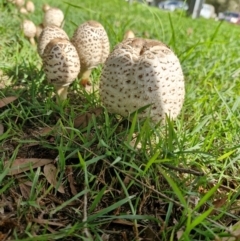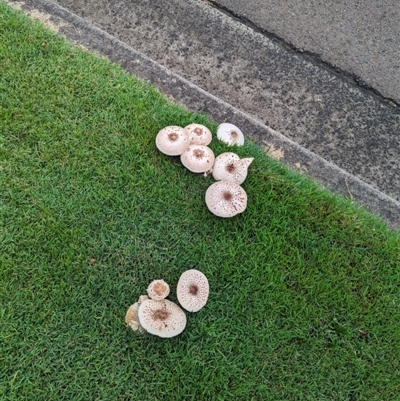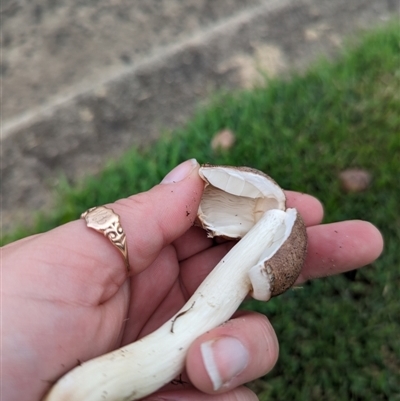Chlorophyllum/Macrolepiota sp.
There are strong similarities between the genera Chlorophyllum and Macrolepiota. This pigeon-hole has been created to (1) have a convenient place for notes about the two genera, (2) as a temporary home for such species and (3) to hold those sightings where there’s some doubt as to which genus a sighting belongs.
Vellinga’s paper documents the seven species thus far known from Australia and gives an identification key. In these mushrooms, as the cap expands, the skin of the cap breaks into concentric scales. Expansion is less towards the centre, hence the scales are denser towards the centre and at the centre the skin remains intact. If the skin is a different colour to the underlying flesh, the central remnant shows as a roughly circular patch of solid colour.
Chlorophyllum molybdites gives a green spore print (a dull & dirty rather than a bright green) and the gills may show a pale, dirty greenish tinge. The others give a white spore print, the gills are white and most are widespread. Here are some notes about them.
Mushrooms almost white overall
Chlorophyllum hortense
- cap with yellowish or pale yellow-brown scales
- stem wine-red when damaged
Macrolepiota dolichaula
- cap with small white scales, a little darker at the centre
- stem not changing colour when damaged
Mushrooms with pronounced brown patches or scales
The first two are rather chunky.
Chlorophyllum brunneum
- cap to 20 cm in diameter
- stem to 14 cm long & 3 wide; white to brownish
Chlorophyllum nothorachodes
- cap to 28 cm in diameter
- stem to 25 cm long & 5 wide; dirty white to brownish
The following are more graceful.
Macrolepiota clelandii
- cap to 12 cm in diameter
- stem to 20 cm long & 1 wide, brown
Macrolepiota eucharis
- cap to 6 cm in diameter
- stem to 15 cm long & 1 wide, dark brown, volva at base
- thus far known only from Queensland
As you’d guess, close study of a specimen may be essential for a correct identification (especially for Chlorophyllum brunneum and Chlorophyllum nothorachodes- distinct microscopically) and sometimes for others as well, given that there can be some variation in the appearance of a species.
Reference
Vellinga, E.C. (2003). Chlorophyllum and Macrolepiota (Agaricaceae) in Australia, Australian Systematic Botany, 16, 361-370.
Chlorophyllum/Macrolepiota sp. is listed in the following regions:
Hunter Region | New South Wales North Coast
Species information
- Chlorophyllum/Macrolepiota sp. Scientific name
- Common name
- Not Sensitive
- Cosmopolitan
- Unknown
- Up to 179.17m Recorded at altitude
- Machine learning















